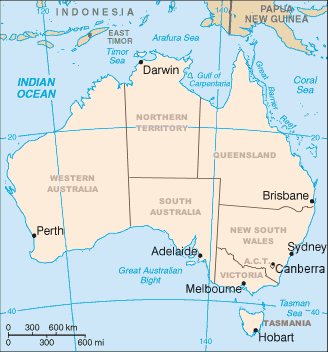 |
| Map of Australia |
History and Demographic Information
 |
| Aboriginal man playing the digeridoo, a traditional musical instrument |
“One of the strongest prejudices that one has to overcome when one visits Australia is that created by the weird jargon than passes for English in this country.” Valerie Desmond
Places to Visit
“Australia is an outdoor country. People only go inside to use the toilet. And that's only a recent development.” Barry Humphries
The Great Barrier Reef is the world’s largest reef. It is located off the northeast coast of Australia
This amazing monolith, which is the largest in the world, is 348 meters high and 9 kilometers around. It is also called “The Heart of Australia” because of it’s location in the middle of the Australian desert. It is made of sand stone which changes color as the light changes during the day. The color can vary from light brown to deep red, with the most spectacular colors at sunrise and sunset. During rainy weather, Uluru looks silvery gray. It is considered sacred by the Aborigines, who have marked its holiness with petroglyphs, rock drawings, around the site for ten thousand years. Visitors can hike around Uluru or up to the top, though the indigenous people prefer that the site not be disturbed by hiking to the top. It is sometimes reported that people who take rocks from Uluru will be cursed. There have been many instances where people who removed such rocks attempted to mail them back to various agencies in an attempt to remove the perceived curse.
 |
| Uluru |
Barossa
This area is Australia Shiraz
 |
| Vineyards in Barossa Valley |
 |
| Penfolds Grange- Australia's most popular wine |
These are only a few of the amazing things to see and do in Australia. There's also exotic wildlife at the Australia Zoo, surfing, the Sydney Opera House, and much more. I can't wait to plan my trip!



























